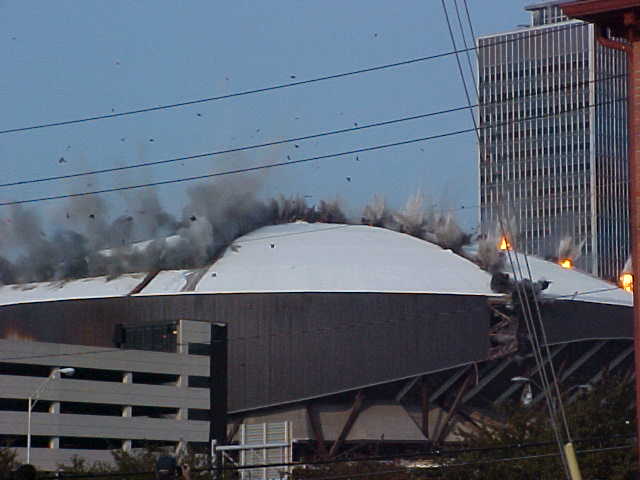MSA: Gone with a bang and a whimper
by Terry Hogan
Market Square Arena, a long-time notable of the Indianapolis skyline, disappeared abruptly at 7am on Sunday, July 8th. In a series of quick, near ear-shattering blasts, the white dome disappeared in a cloud of white and gray smoke and dust. In about 12 seconds, a $24 million landmark was mostly rubble. It went with a bang and a whimper. The bang was supplied by nearly 800 pounds of explosives placed by Control Demolition Inc. The whimper came from many Indianapolis residents, saddened by the loss. The explosion was of sufficient force that seismographs in Bloomington and Muncie, Ind. registered it.
MSA, as it was locally known, was constructed in 1974. It was to host a variety of pro sporting and entertainment events. When the work was completed, it was the 5th largest of this type of structure in the U.S. Glen Campbell was first to use MSA as a springboard to memories in 1974. It was almost sacred ground to those Elvis Presley fans, as this was the site of his last performance on June 26, 1977. Some would have kept it as a shrine, purely for that reason alone. It was the home for the Indiana Pacers, but the Pacers wanted a bigger place to play, with more suites to rent out to large companies. The Field House was built and MSA became expendable -- an 18,000 seat arena without a purpose, occupying key real estate. Its death warrant was signed.
Prepatory work for the implosion began weeks earlier, with the demolition of adjoining parking garages. However the 15,000-ton main structure was destined for implosion, providing one last major event. A series of time explosions were designed to drop key sections of the building in a prearranged sequence. The corner staircases were the first to go. Next, a series of explosions at the roof, already cut, were designed to drop the center part of the roof vertically, creating a void, allowing the remaining sections of the roof to fall toward the center and collapse.
At a cost of $567,000, MSA became rubble, surrounded by an exclusion area to keep onlookers at a safe distance. Of course buildings could not be moved out of the way, but damage appears to have been limited to a few broken windows. Shortly after the demolition, mechanized street cleaners were busily sweeping up dust and debris that covered the adjoining city streets. However Mother Nature decided to put on her own show with a large thunderstorm and heavy rain at 11am to help control the dust.
Several thousand spectators began arriving by 6am to seek the best locations to watch the implosion occur. Indianapolis police were kept busy as folks tried every possible way to sneak inside the perimeter for a better view. Interstates 65 and 70 were closed down for a short period of time to keep spectators from using the elevated highways as a viewing platform to observe the event.
 At 7am, an explosion that was loud enough to trip a few car alarms, marked the beginning of the end. Gray and white smoke vented through the earlier gashes made in the roof. Small pockets of fire along the west side of the roof became momentarily visible, appearing to be pyrotechnic efforts for show rather than substance. All then disappeared in smoke and dust, as if in modesty, MSA chose privacy for her last act. With a series of quick blows, MSA was DOA
At 7am, an explosion that was loud enough to trip a few car alarms, marked the beginning of the end. Gray and white smoke vented through the earlier gashes made in the roof. Small pockets of fire along the west side of the roof became momentarily visible, appearing to be pyrotechnic efforts for show rather than substance. All then disappeared in smoke and dust, as if in modesty, MSA chose privacy for her last act. With a series of quick blows, MSA was DOA
 At 7am, an explosion that was loud enough to trip a few car alarms, marked the beginning of the end. Gray and white smoke vented through the earlier gashes made in the roof. Small pockets of fire along the west side of the roof became momentarily visible, appearing to be pyrotechnic efforts for show rather than substance. All then disappeared in smoke and dust, as if in modesty, MSA chose privacy for her last act. With a series of quick blows, MSA was DOA
At 7am, an explosion that was loud enough to trip a few car alarms, marked the beginning of the end. Gray and white smoke vented through the earlier gashes made in the roof. Small pockets of fire along the west side of the roof became momentarily visible, appearing to be pyrotechnic efforts for show rather than substance. All then disappeared in smoke and dust, as if in modesty, MSA chose privacy for her last act. With a series of quick blows, MSA was DOA